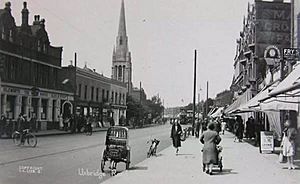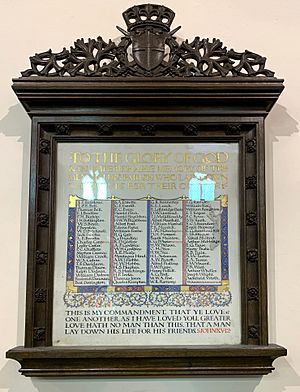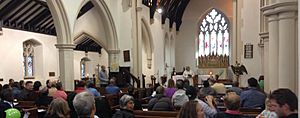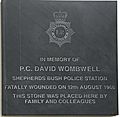St Stephen's Church, Shepherd's Bush facts for kids
Quick facts for kids St Stephen and St Thomas |
|
|---|---|
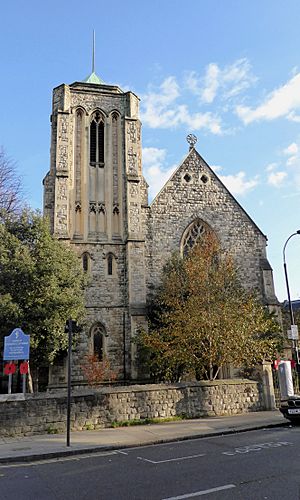
Church of St Stephen and St Thomas, Shepherd's Bush
|
|
| Location | Uxbridge Road, London |
| Country | United Kingdom |
| Denomination | Church of England |
| History | |
| Dedication | St Stephen St Thomas |
| Architecture | |
| Architect(s) | Anthony Salvin |
| Style | Victorian Gothic |
| Years built | 1849-50 |
| Administration | |
| Parish | St Stephen with St Thomas Shepherds Bush |
| Diocese | London |
The Church of St Stephen and St Thomas is a special church in Shepherd's Bush, London. It belongs to the Church of England. This beautiful church was built around 1849–1850. A famous architect named Anthony Salvin designed it in the Gothic Revival style. Today, it is a Grade II listed building, which means it's an important historical place. You can find the church on Uxbridge Road, near Shepherd's Bush tube station.
In the 1950s, St Stephen's welcomed many people from the West Indies. These people are often called the "Windrush Generation". In 1962, Reverend Wilfred Wood became a helper priest here. He later became the first black bishop in the Church of England. In 1966, the vicar John Asbridge started the Shepherds Bush Housing Association. He wanted to help people find homes.
Today, St Stephen's is a church for many different people. It also helps the community by serving hot meals to homeless people every Monday. The church needs some repairs, especially to its roof. People are working to raise money to fix it.
Contents
History of St Stephen's Church
Building the Church in the 1800s
The Church of St Stephen was built between 1849 and 1850. It was designed by architect Anthony Salvin in the Gothic Revival style. This style looks like old medieval churches.
A lot of the money for building the church came from Bishop Blomfield. The land for the church was partly given by James Gomme. There is a special stained-glass window that remembers him.
St Stephen's was one of the "Commissioners' churches." These were Anglican churches built with money from the British Parliament. This happened after the Church Building Act of 1818. Sometimes, the government paid for the whole church. Other times, they gave some money, and the rest was raised by local people.
The church was built using Kentish Ragstone and Bath stone. It had a very well-designed chancel, which is the part of the church near the altar. The beautiful stained-glass windows were made by William Wailes. They were given by church leaders and other people who wanted to help.
The church officially opened in 1850. The area north of Goldhawk Road became its parish. But by 1870, Shepherd's Bush had grown so much that the church was already too small!
In 1850, William Cooke became the first priest in charge of St Stephen's. He was a smart person who wrote many hymns.
The Church During World Wars
During World War I, 91 people from St Stephen's church community died. Their names are written on a war memorial inside the church. Some of them were very brave and received awards. These included Charles Carey, L. W. Moberley, and Captain Charles George Douglas Napier. Captain Napier was a flying ace, meaning he shot down many enemy planes. He was known for his great judgment and daring.
The church was hit by bombs during World War II, around 1940 or 1941. The tall spire was badly damaged and could not be fixed. The original stained-glass windows on the north side of the church were also destroyed. The large windows at the east and west ends were also broken.
After the War: The Windrush Generation
In 1949, workers put up scaffolding to fix the spire. But it was too damaged to save. So, it was taken down and replaced with the shorter, copper spire you see today.
In 1950, the church celebrated its 100th birthday. There was a big celebration and a special dinner.
In the 1950s, many people from the West Indies came to live in Shepherd's Bush. St Stephen's became known as a church that welcomed these new neighbors, who are now called the Windrush Generation. In 1962, Wilfred Wood, who was from Barbados, became a helper priest at St Stephen's. He worked hard for fairness for all people. In 1985, he became the first black bishop in the Church of England. His work still influences the church today, as many West Indian families are part of St Stephen's.
In 1958, the church got a new pipe organ. It was originally made in 1888. It was moved from another church and fixed up.
In 1960, St Stephen's church joined with St Thomas's church. They became one new parish called St Stephen's and St Thomas.
The church has a memorial for PC David Wombwell. He was a police officer who died in 1966.
Shepherds Bush Housing Association: Helping People Find Homes
In 1966, the Reverend John Asbridge, who was the vicar of St Stephen's, started the Shepherds Bush Housing Association. He wanted to help poor people in the area find homes. The church's choir room was used as an office. Volunteers from the church helped run it. Some church members even gave their own houses to the association to help homeless people. Their first project was fixing up an old house into apartments. Reverend Asbridge led the association for 20 years. Today, the Shepherd's Bush Housing Association manages over 5,000 homes.
In 1970, the church became a Listed Building. This means it is protected because of its historical importance.
St Stephen's Church Today
Historic England has listed St Stephen's in its "Heritage at Risk" category. This is because the roof and drains are in poor condition, letting water leak in. St Stephen's has started a campaign to raise £200,000 to fix these problems.
St Stephen's church works closely with the nearby St Stephen's Primary School.
Images for kids
See also



